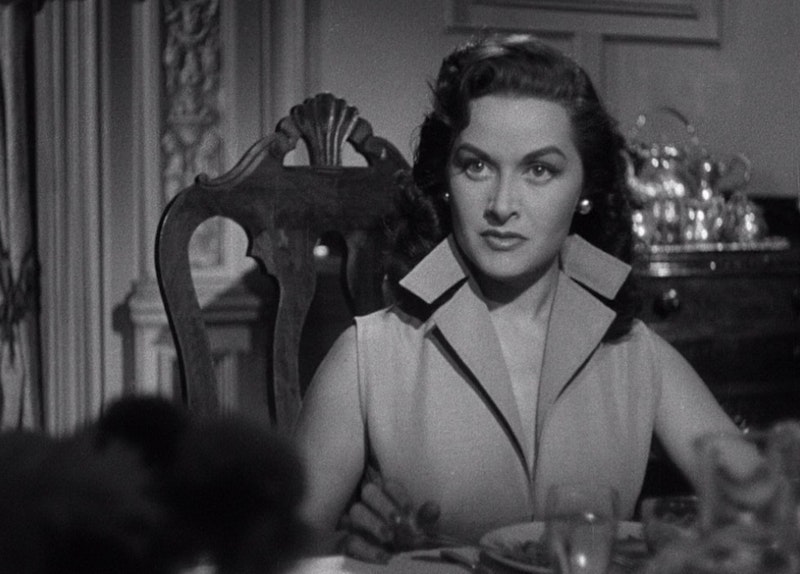Genres are tricky, subgenres doubly so. Sometimes you think you know what kind of story you’re dealing with, and then without having noticed you find you’ve slipped into a completely different shape of tale. And then a story deliberately wrong-foots you, and starts you off thinking it’s one thing before ambushing you with a sharp swerve into another thing entirely.
Thus The Beast Must Die, currently streaming as part of the Criterion Channel’s Argentine Noir collection. It’s definitely an Argentinian film, directed in 1952 by Román Viñoly Barreto, and written by Barreto with Narciso Ibáñez Menta, based on the 1938 C. Day Lewis detective novel. But for some time after it starts you might be forgiven for wondering if it’s really a noir movie.
It opens with a rich man, the despicable Jorge Rattery (Guillermo Battaglia), striding from his fancy car into his big house, where, in front of a crowd including his wife Violeta (Josefa Goldar), her sister Linda (Laura Hidalgo), and his step-son Ronnie (Humberto Balado), he pours himself a drink and promptly dies of the rat poison left in the decanter by party or parties unknown. One leading suspect is Rattery’s houseguest, the mysterious Felix Lane (Narciso Ibáñez Menta). Is Felix really who he says he is? And is he really guilty? Has Violeta finally had enough of Rattery’s abuse? Or Ronnie? Or is Linda tired of Rattery’s crude passes at her?
The opening of the film sets up a traditional country-house murder mystery. A fixed, fairly isolated setting; a limited cast of suspects; motives for everyone present. There’s even a genteel private investigator who makes a brief appearance. But Barreto and Menta are after something different.
At the end of the first act, we drop into what at first seems to be an extended flashback, but turns out to be the body of the movie as a whole. The opening at the house was a framing sequence, setting up a mystery; now we see what was really going on. Starting with the truth about Felix Lane.
Felix turns out to be the pseudonym of a mystery writer named Frank Carter. Some time before, Carter’s beloved son was killed by a hit-and-run driver—who he eventually learns is Rattery, accompanied by Linda. A drive for revenge is born in him, and we watch him set about a scheme to get back at his son’s killers. He arranges a seemingly-accidental meeting with Linda, under his pseudonym. He romances her. He gets her to invite him to Rattery’s house.
This sets up the opening murder, but there’s some way to go before we catch up with the start of the film, aware there are twists and turns waiting. There’s mystery and inevitability. Who’ll find out the truth about Felix? How do we get from what we’re seeing to the opening of the film?
And who takes the decisive action to snuff out a life? Felix is driven by grief, by the death of someone close to him. Will he kill another human? Would that be a justifiable homicide, given how thoroughly despicable Rattery is?
Rattery’s an example of the villain we know too well: a rich man who loves his power, and wields power over everyone around him. He who prides himself on his strength and on humiliating others, without realizing that the only reason other people act as though he’s strong is because they want to use him for his wealth. Wealth is power to Rattery, and it ensures he never has to pay for his crimes. Or does it?
The film’s power lies in the way it makes us both want to see Rattery dead, and also hope that nobody else is corrupted by doing the murder. Rattery’s evil is that he has no fellow-feeling for other people. If someone were to kill him, they’d have to repress their empathy in exactly the way Rattery does: they would become like him. We know that in the end somebody does this. Who?
All along we watch Felix, and evaluate his actions. The way he lies to Linda. The way he focuses on revenge. This is the traditional noir story of a man pulled step by step deeper into wrongdoing. In this case, though, the nominal femme fatale is herself a victim.
The film’s visual sense echoes its play with genres. The opening country-house scenes are shot with lots of light and careful attention to geography and blocking, introducing the cast and setting up key settings and props. And then it goes into flashback, and the lighting is far more shadowed, more atmospheric. We see how the movie’s changed genres; the cozy country-house murder becomes a facade for a much bleaker noir.
The movie becomes about good and evil. The beast must die, says the title, and that’s a biblical reference—to Ecclesiastes 3:19, which says that what happens to humans is what happens to beasts, “as one dies, so dies the other.” Is there a difference between man and beast? Everyone in the movie acts beastly to somebody else, at some point. Unlike animals, humans use language, whether for talking or for writing; but what if they use language to lie?
As in the best stories, the resolution is thoughtful and unexpected, in theme as well as plot. It’s an excellent crime tale, impeccably crafted and well-acted, and never what it seems. It plays with form and genre, and the nature of storytelling. It’s powerful work; an example of at least two different subgenres of murder mystery, but also even rarer and more striking than that.

